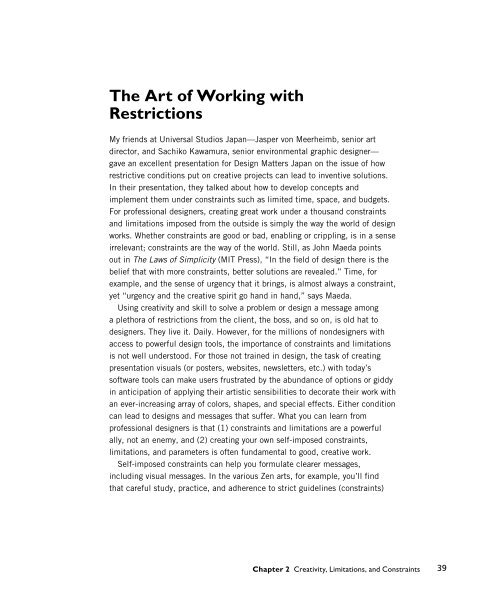Making-Original-Products-presentationzen
Create successful ePaper yourself
Turn your PDF publications into a flip-book with our unique Google optimized e-Paper software.
The Art of Working with<br />
Restrictions<br />
My friends at Universal Studios Japan—Jasper von Meerheimb, senior art<br />
director, and Sachiko Kawamura, senior environmental graphic designer—<br />
gave an excellent presentation for Design Matters Japan on the issue of how<br />
restrictive conditions put on creative projects can lead to inventive solutions.<br />
In their presentation, they talked about how to develop concepts and<br />
implement them under constraints such as limited time, space, and budgets.<br />
For professional designers, creating great work under a thousand constraints<br />
and limitations imposed from the outside is simply the way the world of design<br />
works. Whether constraints are good or bad, enabling or crippling, is in a sense<br />
irrelevant; constraints are the way of the world. Still, as John Maeda points<br />
out in The Laws of Simplicity (MIT Press), “In the field of design there is the<br />
belief that with more constraints, better solutions are revealed.” Time, for<br />
example, and the sense of urgency that it brings, is almost always a constraint,<br />
yet “urgency and the creative spirit go hand in hand,” says Maeda.<br />
Using creativity and skill to solve a problem or design a message among<br />
a plethora of restrictions from the client, the boss, and so on, is old hat to<br />
designers. They live it. Daily. However, for the millions of nondesigners with<br />
access to powerful design tools, the importance of constraints and limitations<br />
is not well understood. For those not trained in design, the task of creating<br />
presentation visuals (or posters, websites, newsletters, etc.) with today’s<br />
software tools can make users frustrated by the abundance of options or giddy<br />
in anticipation of applying their artistic sensibilities to decorate their work with<br />
an ever-increasing array of colors, shapes, and special effects. Either condition<br />
can lead to designs and messages that suffer. What you can learn from<br />
professional designers is that (1) constraints and limitations are a powerful<br />
ally, not an enemy, and (2) creating your own self-imposed constraints,<br />
limitations, and parameters is often fundamental to good, creative work.<br />
Self-imposed constraints can help you formulate clearer messages,<br />
including visual messages. In the various Zen arts, for example, you’ll find<br />
that careful study, practice, and adherence to strict guidelines (constraints)<br />
Chapter 2 Creativity, Limitations, and Constraints<br />
39



